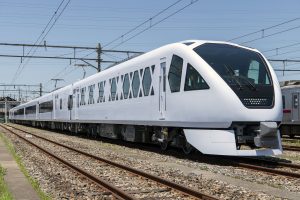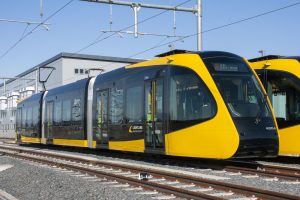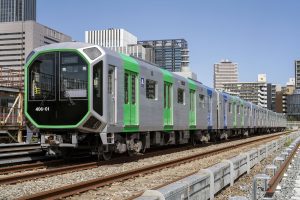JRC 2024 Blue Ribbon Prize and Laurel Prize
May 23, 2024
Japan Railfan Club, President Hiroshi Saeki, approximately three thousand members, awarded 2024 Blue Ribbon Prize to Tobu Railway Company series N100 as the most excellent rolling stock.
Also, Utsunomiya Light Rail Co.,Ltd.’s type HU300 and Osaka Metro Co., Ltd. Series 400 have chosen 2024 Laurel Prize as excellent rolling stock.
These awards were decided by the Blue Ribbon Prize & Laurel Prize Selection Committee of JRC (BR&LPSC). Also Blue Ribbon Prize chosen based on the club member’s vote as the best rolling stock, while Laurel Prize chosen by discussion of BR&LPSC members as recognizing excellence equipment.
“The 67th” Blue Ribbon Prize
Tobu Railway Co., Ltd. series N100
“The 64nd” Laurel Prize
Utsunomiya Light Rail Co.,Ltd.’s type HU300
“The 64nd” Laurel Prize
Osaka Metro Co., Ltd. Series 400
Blue Ribbon Prize
Tobu Railway Co., Ltd. series N100
Tobu Railway series N100 (Spacia X) is a new express train that connects Asakusa with Nikko/Kinugawa area. It is a high quality flagship express train that has evolved with the times while maintaining and inheriting the traditions that the series 100 Spacia has built up over the years. The exterior has been evolved to a modern design, and both leading cars have window frame structures reminiscent of traditional crafts such as kumiko and bamboo weaving. The interior is designed with symbols of Edo culture as design accents, and a color assortment inspired by the color plan “48brown and 100 white”
The car #1, which is Tobu Nikko side has a cockpit lounge with a café counter, and the car #6 which is Asakusa side, has one cockpit suite with a capacity of 7 people and four passenger compartment with a capacity of 4 people. In addition, in car #2, premium seats with electric reclining and back shell structure are arranged in three rows of standard seats side by side. In car #3 to #5, there are four rows of standard seats side by side, and two semi-private box seats are installed in the Nikko side area of car #5. There are five free large luggage storage areas on the deck.
The car body is an aluminum double-skin structure, and the front section is formed by welding parts made of three dimensionally machined aluminum steel. The bogies are monolink axle box supported bolsterless bogies, and both leading cars and the premium seat car have acceleration sensors installed in the car bodies that detect running vibrations and operate actuators mounted on the bogies to dampen the viblation.
The main circuit is controlled by a totally enclosed induction motor using Hybrid-SiC, which combines IGBT and SiC diodes, and the brake system is an electrically commanded air brake with regenerative brake. Each car is equipped with a brake control unit, and transmission to the vehicle information control system enables electro-pneumatic calculations for the entire train. The air compressor is an oil-free scroll type, and the auxiliary power supply is an IGBT type SIV. The side display is a glass signage with a 28.6 inch LCD, and is structured to be flat with the steel body.
It received the most support isn the member votes, and the selection committee also evaluated it as the most excellent vehicle worthy of the Blue Ribbon Award from many points of view.
Laurel Prize
Utsunomiya Light Rail Co.,Ltd.’s type HU300
The HU300 is the first all-new LRT in Japan for the Haga-Utsunomiya LRT, with 17 units newly manufactured and introduced. It is a 100% low –floor light rail vehicle with a 3-car body and 3-bogie articulated structure.
It is based on the old Adrranz type vehicle configuration that has been introduced on the Kumamoto City tram and Toyama Light Rail since 1997, but it has new design for the line, which is opening with an aim to create a new form of urban transportation.
The vehicle specifications are a gauge of 1067mm and a total length of 29.52m, which is the maximum length of 30m allowed by the Track Act. The capacity is 159people, the largest for low-floor vehicles, and the car bode and bogies are basically the same as the previous model, but the control device is a new one that uses IGBTs based on SIC. The exterior is based on the concept of “Bringing the City to the Future” and was designed based on the results of a public survey. It has a yellow base color, a large curved glass on the front of the vehicle to ensure forward visibility, and the height of the car. In addition, more than 60% of the members voted for this vehicle.
Laurel Prize
Osaka Metro Co., Ltd. Series 400
The Osaka Metro Subway series 400 is the first new series introduced since the change of management structure, with the aim of transporting passengers in connection with the extension of the Chuou Line to Yumeshima Station and the 2025 World Expo, 23 six-car trains are scheduled to be manufactured by April 2025.
The exterior is positioned as futuristic route in line with the transportation purpose, with a design reminiscent of a spaceship. The car body is made of aluminum alloy and has an aluminum double-skin structure using friction stir welding, and the distinctive front structure is 3D machined to achieve high precision and beautiful curves. The front of the train is designed to emphasize visibility from the cab and the view from inside the passenger compartment, with large glass areas on each side and headlights and taillights at the four corners, taking advantage of the shape of the train resemble a polyhedron. The emergency door to secure an evacuation route at the front of the train is narrow on all sides, but it is placed on the right half of the cab and the entire front is painted black so that it does not stand out.
The latest level of equipment, including electrical equipment, has been adopted as in conventional trains and changes have been made as necessary. As for information equipment, a system that constantly monitors the status of the vehicle and transmits it to cloud server on the ground to improve the efficiency of preventive maintenance and a transmission system has been developed to send and receive commands and vehicle status necessary for automatic driving between the transport command center and the vehicle in preparation for the automatic driving demonstration experiment. In addition, this year, a demonstration experiment of automatic driving is scheduled to be conducted between Osaka Port and Yumeshima Station.
Interior of this cars, the seats facing each other between the side entrance are shifted toward the track to endure both seating capacity and space that is easy for passengers with large luggage to use. The seat backs are higher than those of conventional cars to improve seating comfort. In addition three single-seater fixes cross seats are provided between the side entrances of car #4 to meet the demand for personal space and the enjoyment of traveling. In addition, to meet diversifying needs, a counter with a USB outlet is located in the equipment room space near the end of the middle side of the leading car.
The selection committee selected the series 400 for the Laurel Award, praising its design that sets it apart from existing series cars and its facilities that meet diverse needs.




